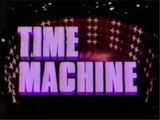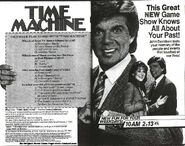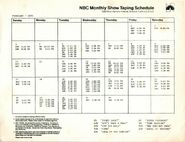| Host | |
| John Davidson | |
| Announcer | |
| Charlie Tuna Rich Jeffries (sub) | |
| Broadcast | |
| Pilot: 1984 NBC Daytime: 1/7/1985 – 4/26/1985 | |
| Packager | |
| Reg Grundy Productions | |
FORMAT #1 SPIEL:
(the set slowly appears) "(insert contestant #1), (insert contestant #2), and (insert contestant #3). They're with us today on TIME MACHINE! And now, here's John Davidson!"
FORMAT #2 SPIEL:
"Today, a brand new car could go to the player who can tell us when (insert event). Join us, as we take a journey back through time on TIME MACHINE! And now, here's John Davidson!"
Time Machine was a game show that focused on pop culture in time, events and history, similar to The Price is Right.
Gameplay[]
Contestants played a series of mini games about recent historical events in order to win cash & prizes. One lucky contestant by the end of the show would have a chance to play for bigger prizes.
Main Game[]
The show went through two formats in its four-month run.
Format #1[]
During the first five weeks, three contestants competed each show. This format was basically The Price is Right but all about history. The third game of that day's show was always played by the returning champion. Prizes & cash won from mini games were put into a Prize Bank which could be claimed in a playoff later in the show.
Mini Games (Format #1)[]
There were at least six mini-games used during the first format. They were:
- Tube Game – This was game all about television shows past & present. To start, a year was given to the player. The contestant was shown pictures of two shows, and host Davidson provided the names. The contestant had to pick which one was airing in the given year. This process was done three times - the first with ABC shows, the second with NBC shows, and the third with CBS shows. A right answer won the corresponding network, but a wrong answer lost it. Behind one of the networks was a prize package; if the contestant had captured that network, or if he/she got all three right, it was added to his/her Prize Bank.
- 3 In A Row – This was basically a tic-tac-toe game, but it was played with a certain decade; because in each square of a tic-tac-toe board was a different year, all from the same decade. Originally, before the game started, the contestant placed three "Poison Cards" in a row on the board. He/She was then shown nine events to choose from. The contestant picked an event, and the year in which it happened lit up. If he/she lit three years across or up-and down, a prize was added to his/her Prize Bank, but for lighting up three years in a row diagonally, a bigger prize was added to the bank. However, if the three squares in a row with the Poison Cards lit up, he/she lost. Later, the Poison Cards were eliminated, and the events were written on cards drawn from a podium two at a time. The contestant picked an event from the two choices, and (again) the year it happened in lit up. Each time an event was chosen, another event replaced it. The game continued until they got three in a row. This time the contestant lost if he/she lit three in a row diagonally. Lighting three in a row across or up-and-down still added a prize to his/her Prize Bank.
- As Time Goes By – To begin, the contestant was given one free spin. Three photos of the same celebrity were shown, and the contestant had to guess what year each photo was taken. If his/her guess was within five years of each exact answer, he/she won another spin. After all three photos were played, the player then took his/her spins to the game clock, which was a spinner made up to look like a clock. The area around the 12:00 area was painted red. The pointer moved automatically, and the contestant watched it for a few seconds. He/She then turned away with his/her back to the clock and hit a plunger to stop the pointer. If the player landed at the red area, he/she won a prize which was added to his/her prize bank. If not, they tried again until they ran out of spins, which resulted in a loss.
- Before or After – To start, the contestant was given $200 and a base year. His/her job was to guess whether an event happened before or after the base year. A correct guess doubled the money; nothing happened for an incorrect guess. Either way, the year of that event became the new base year. The process was repeated two more times. Then, on the final event, the contestant was given a choice to either stop and put the money into his/her Prize Bank, or go play that final event. A correct guess doubled the money and put it in the Prize Bank; a wrong guess lost the money.
- Sweet Sixteen – This was played similar to the Price is Right pricing game Lucky $even. To start, the contestant was given sixteen $100 bills (for a total of $1,600). He/She was shown up to four old products. On each product, the player had to guess what year it was introduced. For each year his/her guess was off, he/she lost a $100 bill. The first three products were given specific ranges to aid the contestant (sometime in the 1950s, sometime in the last 10 years), but the final one had no range. At the end of the game, if the player had any money leftover (as low as $100 left), he/she added a prize into his/her Prize Bank plus any leftover money.
- Main Event – A base year was given along with five categories. The contestant picked the category he/she was the least comfortable with, and instantly won that category. He/She then picked the remaining categories one-by-one. Each category had one question relating to the base year, and each question had two possible answers; guessing right won the category, but guessing wrong lost it. After all five categories were played, the contestant would select the categories that he/she earned, revealing clues to the "Main Event," which occurred in the base year. The clues were revealed one-by-one. Guessing the Main Event put $5,000 in the Prize Bank, with $1,000 deducted for each subsequent clue revealed.
Time Capsule[]
In the Time Capsule round, the three contestants who played their games competed. They were given five events from a certain year (with the final event being a song; a clip of it was played for the contestants). Each player locked in a year which they thought was the correct year all the events took place before giving their guess. Host Davidson then gave the correct year and the player with the closest year, high or low, won the game, kept all the cash & prizes in his/her prize bank, and became Time Machine champion. In early shows, winning the game also won $1,000.
Format #2[]
Starting on February 11, two contestants battled it out in three games for the right to face the show's returning champion. A win in each mini-game earned points. This time, cash & prizes were no longer added to a prize bank; all cash & prizes won by the contestants were theirs to keep, win or lose.
Mini Games (Format #2)[]
Four of the mini-games from the first format were carried over into this format but with altered rules. Others were retired and given life to new games. There were two lineups of games that alternated turns from show to show.
Lineup #1[]
- Game 1: As Time Goes By – As before, three photos of a celebrity were shown. Only this time the contestants played a Q & A game similar to the Card Sharks "Hi-Lo Toss-Up Questions", one player guessed the year when the photo was taken, and the other player guessed whether the actual year was higher or lower than the first player's guess. If the second player's answer was right he/she won the question, but if the second player's answer was wrong the first player won the question. The first player also won if his/her guess was exactly right. The winner of each question won a spin at what was now the "Money Clock", which now had four spaces. The four spaces read zero, $100, $300, and $1,000, with the $1,000 space much smaller than the rest. As before, the contestant watched the pointer for a few seconds, then turned away from it before stopping the clock by hitting a plunger. Whatever money space was landed on, that was the amount of dollars the player with that spin won. The player with the most money (or who won all three questions) won the game, and kept whatever they won on the Money Clock (up to $3,000).
- Game 2: Tube Game – Host Davidson asked a series of questions about three TV shows from a given year. All questions were toss-ups and the first player to buzz-in with a correct answer scored a point. On the first three questions, Davidson described each show; the first was an ABC show, the second was an NBC show, and finally the third was a CBS show. After that, he asked questions pertaining to the three described shows. The first player to answer five questions correctly won the game and a prize.
- Game 3: Jukebox Game – Four jukeboxes were shown, each branded with a different year from a certain decade. On each jukebox, a song was played, and two possible artists were given. The first player to buzz-in with the right artist won the right to match the song with the year it was released. If they got a match, they won that song. If they missed, their opponent got one chance to pick the right one and steal the song. The jukebox with the right answer was eliminated from play regardless. If all the jukeboxes were eliminated, then the contestants just had to identify the song's artist to win it, without having to match it to a year. The first player to win three songs won the game and a prize.
Lineup #2[]
- Game 1: On The Button – This game used the same set and question-type as the now-retired "Sweet Sixteen". An item was given, and one player guessed what year the item was introduced. Getting it exactly right scored that item for that player, but getting it wrong allowed host Davidson to say whether the item was introduced earlier or later/before or after that year, and then the other contestant had a chance to guess. They see-sawed back and forth until either player guessed the right year. This continued until one player won three items, which won them the game and a prize.
- Game 2: 3 In A Row – Just like before, each square of a tic-tac-toe board had a different year from the same decade. One line of three squares were marked with stars on them, which made up the "Magic 3 In A Row". One player was given two events and then picked an event from the two choices; the year it happened in then lit up. Lighting up a magic three-in-a-row square won $100 to the player that did so. A new event took the selected one's place, and the other contestant picked one. This continued until the magic three-in-a-row was completed. The person who lit up the last square that caused the magic three-in-a-row won the game and a bonus prize.
- Game 3: Main Event – As before, a base year and five categories were all given. Behind those categories were two possible answers to a question. To start, $200 was put into a pot. The contestants alternated turns picking categories and answering questions. Each correct answer added another $200 in the pot. After all the categories were played, clues to the "Main Event" were revealed one at a time. The first contestant to buzz-in and solve the Main Event, won the game and all the money in the pot (up to $1,200).
The first two games were each worth one point and the third was worth two points. The player with the most points won the right to face the returning champion. In case of a 2-2 tie, the first player to buzz in and correctly answer a tie-breaker question won the game.
Challenge Round[]
This was played the same as Time Capsule, except of course that only two contestants competed. As before, the closest guess won the game.
Bonus Round[]
The bonus round focused on headlines from certain years. There were two versions of the bonus game. In the early weeks, contestants played for a jackpot of prizes totalling at least $20,000, including a new car. Later they played for a new car only.
Version #1[]
In this version, host Davidson asked one final question with four possible events. The championship player's job was to choose the event which happened in the given year to win the $20,000 jackpot prize package. This bonus did not play unless the contestant guessed the exact year in the Time Capsule.
Version #2[]
In this version to start, host Davidson gave a base year, then gave four events to the winning contestant one by one. The champion's job was to guess whether each event occurred before or after the given year. Each correct answer moved on to the next event, but an incorrect answer ended the game. If the champion could get all four questions right, he/she won the jackpot prize package plus a cash jackpot which started $1,000 and grew by that amount for each day it was not won.
When the second main game format came around, the jackpots were replaced with a brand new car. On a champion's first go, he/she needed four correct answers to win. The second day required three, third day two, and fourth day only one. Winning five days in a row automatically won the car. Under this format, the champion retired when he/she won and the contestant they defeated in the Challenge Round (or main game should they dethrone the champion in the same show) became the new champion.
Rating[]
Music[]
Ray & Marc Ellis
Inventor[]
Bill Barr
Studio[]
NBC Studios, Burbank, CA
Trivia[]
Future Card Sharks dealer Susanna Williams worked as one of the prize models on the show (alongside other models named Chris, Mark, and Patty).
This was the first game show hosted by John Davidson.
This game show replaced reruns of the popular sitcom The Facts of Life on NBC's daytime schedule in January 1985 but was replaced by The Facts of Life reruns on April 29th of that year; the other game show NBC considered for that time slot was Fast Friends.
Sound Effects[]
The sound which sounded when a picture was revealed in the Tube Game was later carried over into The Hollywood Game.
The sound for while the spinner was spinning on the clock in the game As Time Goes By was later used on the Fame Game board after it switched to randomizer mode on Sale of the Century.
Two other sounds (the bell, the ticker and an answer reveal sound) used on this show were also used on fellow Reg Grundy Production Scrabble.
Tagline[]
"It's time to go back/We return you to the year 1985. Make the most of today, and come back and join us on Time Machine. Bye." - John Davidson
Links[]
Time Machine (Format #1) @ Game Show Garbage
Time Machine (Format #2) @ Game Show Garbage
YouTube Videos[]
Premiere Show
Show #5 (with Rich Jeffries sub-announcing)
Another Episode
Finale



